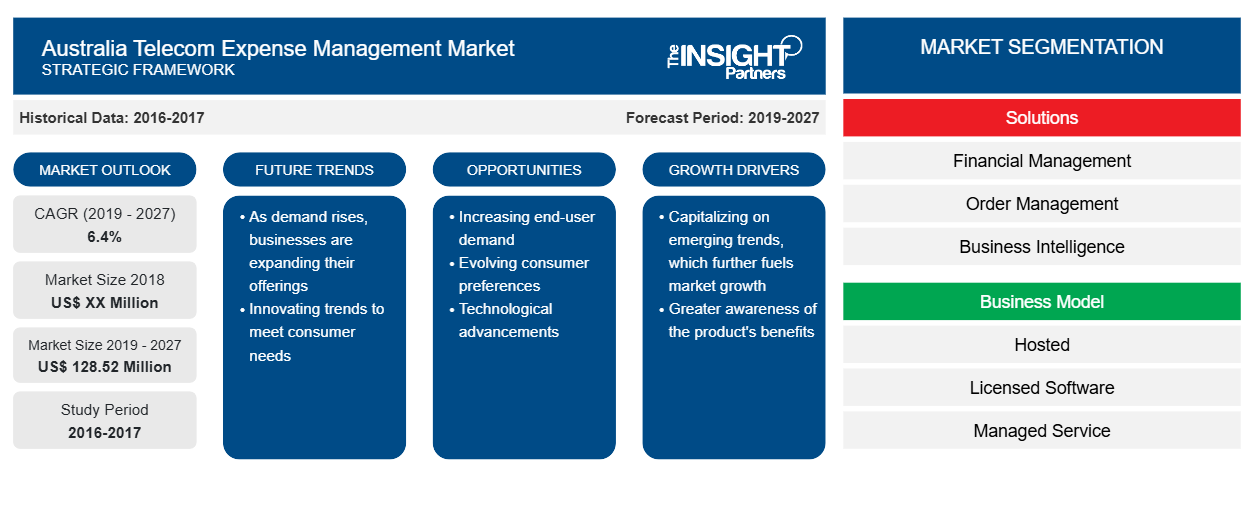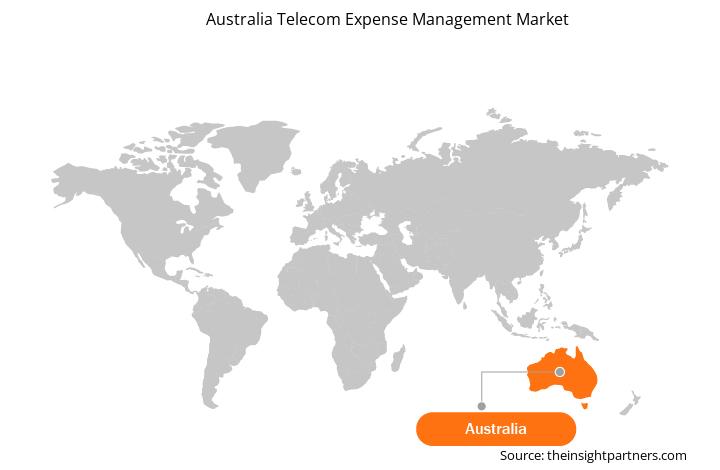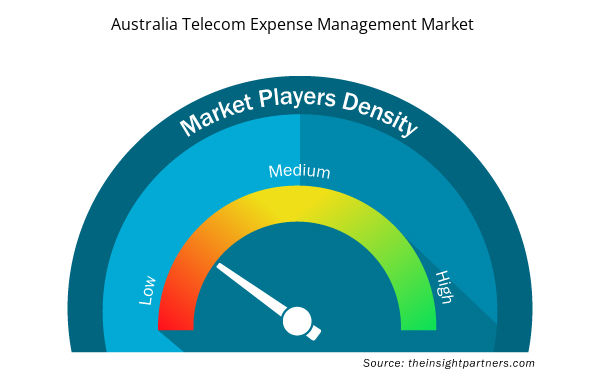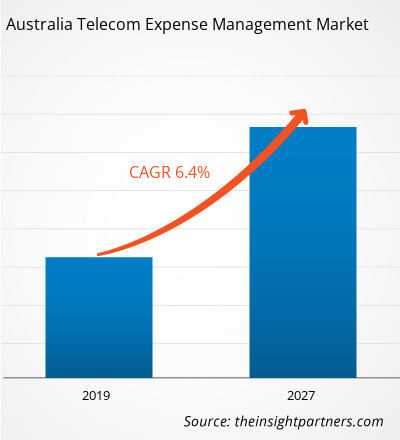The Australia Telecom Expense Management Market is estimated to be valued at US$ XX Mn in 2018 end and is expected to touch a figure of nearly US$ 128.52 Mn by 2027 end representing a CAGR of 6.4% over the forecast period.
The communication plays a vital role in seamless business processes, the function of critical enterprise operations and subsequently, the growth of the business. Moreover, the large scale geographical presence of the enterprise processes and its subsidiaries has further added to the demand for a robust and efficient enterprise communication solution and services along with its periodic maintenance as well as function. As a result, the surge in the number of telecom assets, asset provisioning, financing, maintenance, optimization, and management of telecom expense could gain complexities with the increase in enterprise size and business operations. Thus, the Australia Telecom Expense Management Market is poised to provide significant profitable business opportunities for the market players during the coming years.
Lucrative Australia Telecom Expense Management Market By Revenue

- This FREE sample will include data analysis, ranging from market trends to estimates and forecasts.
- This FREE sample will include data analysis, ranging from market trends to estimates and forecasts.
Australia Telecom Expense Management Market Insights
The rise in demand for 5G enabled telecom services and solutions
The integration of state of the art technology enabled 5G telecom services has attracted significant traction across significant economies, including Australia. Factors such as higher bandwidth resulting in superior internet and data services along with scope for innovative augmented and virtual reality enabled solutions is further expected to fuel the growth of the 5G enabled services. The Australian Communications and Media Authority (AMCA) has promised to accommodate modifications in its existing spectrum allocation towards maximizing the benefits of implementation of 5G services for both its commercial and retail end-users. Moreover, the Australian government has ensured the spectrum availability along with assistance in necessary regulatory and infrastructure arrangements towards the timely implementation and subsequently the availability of the 5G enabled services by the end of 2019 or 2020. Consequently, providing numerous attractive business opportunities for the Australia telecom expense market players during the forecast period.
Significant rise in penetration of TEM solutions across SMEs
The swift reduction in IT infrastructure and digital costs, coupled with an emphasis towards operational efficiencies has boosted the growth of TEM based solutions across the small and medium enterprise owners. Moreover, the availability of versatile benefits over the conventional telecom expense management along with an increase in flexible service offerings from the telecom services provider is also anticipated to add to the complexity of telecom expense management through conventional solutions. Thus, propelling the penetration of TEM based numerous solutions and managed services across the large pool of small & medium enterprise owners across the Australian region. According to data accessed from the Australian government website, the small & medium enterprise employs about 44% of the total Australian population, i.e., 4.8 million of and contributed 35% of the overall industry value added (IVA) in 2017.
Australia Telecom Expense Management Market – End-user Insights
The significantly large number of users of telecom service such as fixed, mobile, and data for seamless business communication requirement has driven the number of telecom-based assets, devices, services, and solutions. Moreover, the rise in labor costs equipped with budget constraints and fluctuation in service offerings has complicated the task of management of telecom expenses efficiently. As a result, the enterprise owners’ especially large and medium enterprises apart from telecom service provider have attracted significant demand for numerous TEM based solution and services. The large enterprise owing to significantly large scale organizational presence and massive operation has attributed in demand for efficient and robust business communication-based solution and assets. Moreover, the substantial complexities in telecom provisioning, management, allocation, and tracking of various telecom expense have resulted in the notable market share of the large enterprise. Thus, the large enterprise accounted for the significant market share presently and are expected to maintain its dominance in the Australia telecom expense management market during the coming years.
Australia Telecom Expense Management Market – Business Model Insights
Currently, the companies operating in Australia telecom expense management market provide a wide range of solutions through professional and managed services. Furthermore, the continuous advancement in technological capabilities in the business communication such as hosted PBX, unified communications, and other disruptive technologies also have a significant impact over the market player value offerings and subsequently their business model. As a result, based on the business model, the Australian telecom expense management market is segmented into hosted, licensed software, managed service, and total outsourcing business models.
Australia Telecom Expense Management Market – Solutions Insights
Presently, the leading telecom expense management based market players offer a broad range of solutions as well as related managed services for distinguishing their core offerings from market competitors. Moreover, the significant presence of many market players across Australian as well as other major geographical regions along with high market competition has attributed in the highly fragmented nature of the market. As a result, the leading market players have extended their solution features beyond current offerings to accommodate additional value-added solutions and services. For instance, some of the commonly offered features through telecom expense management solutions and services being offered currently are financial management, business intelligence, reporting & analytics, consulting, contract management, and sourcing management among other additional features. Thus, based on solutions the market is broadly classified into financial management, order management, business intelligence, inventory management, contract management, dispute management, and others (sourcing management, design & optimization management, and security management) segments.
Australia Telecom Expense Management Market Revenue by End-user (USD Mn)

- This FREE sample will include data analysis, ranging from market trends to estimates and forecasts.
- This FREE sample will include data analysis, ranging from market trends to estimates and forecasts.
Australia Telecom Expense Management Market -
Customize This Report To Suit Your Requirement
You will get customization on any report - free of charge - including parts of this report, or country-level analysis, Excel Data pack, as well as avail great offers and discounts for start-ups & universities
Australia Telecom Expense Management Market: Strategic Insights

- Get Top Key Market Trends of this report.This FREE sample will include data analysis, ranging from market trends to estimates and forecasts.
You will get customization on any report - free of charge - including parts of this report, or country-level analysis, Excel Data pack, as well as avail great offers and discounts for start-ups & universities
Australia Telecom Expense Management Market: Strategic Insights

- Get Top Key Market Trends of this report.This FREE sample will include data analysis, ranging from market trends to estimates and forecasts.
Market Initiatives was observed as the most adopted strategy in the Australia Telecom Expense Management Market. Few of the recent market initiatives adopted by some of the leading market players operating in the Australia Telecom Expense Management Market are listed below;
2019:
Accenture announced that the company has earned Efficiency First Solution Certificate in TEM from AOTMP.2019:
Calero and Crown Commercial Service together launched RM3802 Technology Expense Management Framework for public sector organizations in UK.2018:
Calero Software acquitted Netherland based TEM provider A&B Groep to expand Calero’s technical, customer service as well as commercial operations in Europe.AUSTRALIA TELECOM EXPENSE MANAGEMENT MARKET SEGMENTATION
Australia Telecom Expense Management Market – By Solutions
- Financial Management
- Order Management
- Business Intelligence
- Inventory Management
- Contract Management
- Dispute Management
- Others
Australia Telecom Expense Management Market – By Business Model
- Hosted
- Licensed Software
- Managed Services
- Total Outsourcing
Australia Telecom Expense Management Market - By End-user
- Small & Medium Enterprise
- Large Enterprise
Australia Telecom Expense Management Market - Company Profiles
- Accenture plc
- Avotus Corporation
- Calero Software, LLC
- CGI Inc.
- CIMPL Inc.
- Emersion Software Systems Pty Ltd
- Tangoe, Inc.
- Telstra Corporation Limited
- Valicom
- VoicePlus Pty Ltd
Australia Telecom Expense Management Market Regional Insights
The regional trends and factors influencing the Australia Telecom Expense Management Market throughout the forecast period have been thoroughly explained by the analysts at Insight Partners. This section also discusses Australia Telecom Expense Management Market segments and geography across North America, Europe, Asia Pacific, Middle East and Africa, and South and Central America.

- Get the Regional Specific Data for Australia Telecom Expense Management Market
Australia Telecom Expense Management Market Report Scope
| Report Attribute | Details |
|---|---|
| Market size in 2018 | US$ XX Million |
| Market Size by 2027 | US$ 128.52 Million |
| Global CAGR (2019 - 2027) | 6.4% |
| Historical Data | 2016-2017 |
| Forecast period | 2019-2027 |
| Segments Covered |
By Solutions
|
| Regions and Countries Covered | Australia
|
| Market leaders and key company profiles |
Australia Telecom Expense Management Market Players Density: Understanding Its Impact on Business Dynamics
The Australia Telecom Expense Management Market is growing rapidly, driven by increasing end-user demand due to factors such as evolving consumer preferences, technological advancements, and greater awareness of the product's benefits. As demand rises, businesses are expanding their offerings, innovating to meet consumer needs, and capitalizing on emerging trends, which further fuels market growth.
Market players density refers to the distribution of firms or companies operating within a particular market or industry. It indicates how many competitors (market players) are present in a given market space relative to its size or total market value.
Major Companies operating in the Australia Telecom Expense Management Market are:
- Accenture plc
- Avotus Corporation
- Calero Software, LLC
- CGI Inc.
- CIMPL Inc.
Disclaimer: The companies listed above are not ranked in any particular order.

- Get the Australia Telecom Expense Management Market top key players overview
- Historical Analysis (2 Years), Base Year, Forecast (7 Years) with CAGR
- PEST and SWOT Analysis
- Market Size Value / Volume - Global, Regional, Country
- Industry and Competitive Landscape
- Excel Dataset



Report Coverage
Revenue forecast, Company Analysis, Industry landscape, Growth factors, and Trends

Segment Covered
This text is related
to segments covered.

Regional Scope
North America, Europe, Asia Pacific, Middle East & Africa, South & Central America

Country Scope
This text is related
to country scope.
Trends and growth analysis reports related to Technology, Media and Telecommunications : READ MORE..
The List of Companies
- Accenture plc
- Avotus Corporation
- Calero Software, LLC
- CGI Inc.
- CIMPL Inc.
- Emersion Software Systems Pty Ltd
- Tangoe, Inc.
- Telstra Corporation Limited
- Valicom
- VoicePlus Pty Ltd

 Get Free Sample For
Get Free Sample For